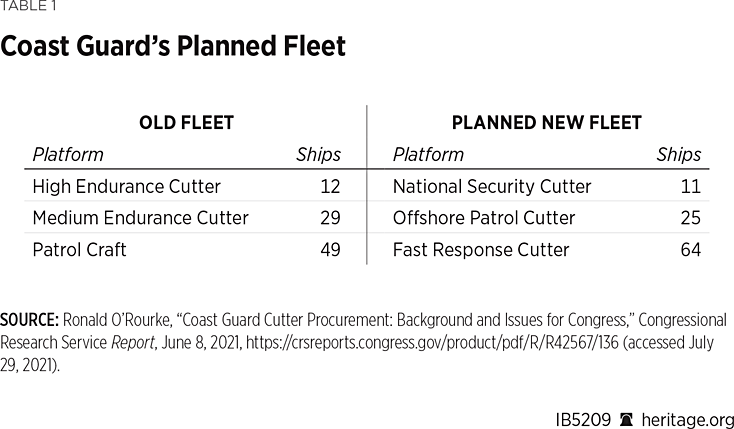U.S. Coast Guard Commandant Admiral Karl Schultz recently described how the Coast Guard’s role is growing. Coast Guard cutters have been deployed to the Taiwan Strait and the European theater to enhance U.S. leadership abroad and have conducted anti-narcotics patrols in the Eastern Pacific and Caribbean that play a critical role in disrupting the drug trade. The Coast Guard is also working with partner nations across the globe to support maritime security and international norms and strengthen partnerships—in addition to protecting America’s exclusive economic zones (EEZ) and home waters.REF
It does all of this with a budget roughly the cost of one of the Navy’s Ford-class aircraft carriers and a fleet of ships desperately in need of modernization.REF Thankfully, there is an opportunity for Congress in the fiscal year (FY) 2022 budget process to help strengthen the service by taking three concrete actions.
1. Mandate an Update to the Program of Record
The Coast Guard last updated its Program of Record (POR), the document that lays out its fleet needs, in 2004. According to that document, the Coast Guard would acquire eight National Security Cutters (NSCs), 25 Offshore Patrol Cutters (OPCs), 58 Fast Response Cutters, and six polar-capable icebreakers. These programs are designed to replace the existing 90 high- and medium-endurance cutters and patrol craft and the aging Polar Star icebreaker. These vessels are designed as multi-mission cutters and will execute seven of the 11 Coast Guard mission sets while out on patrol, including search and rescue, drug and migrant interdiction, and defense readiness missions.REF
However, much has changed in the world since 2004, with the maritime environment only getting busier and more complicated with the return to great-power competition. While the requirements for the Coast Guard are primarily based on geography, it is becoming more and more active in the broader maritime security dynamic, which could increase overseas deployments. A Coast Guard analysis from 2009 estimated that the existing POR accounts for only 61 percent of the cutters needed to fulfill the Coast Guard’s needs.REF That analysis also showed the service had capability and capacity gaps across its mission sets. While the POR calls for 25 OPCs, this later analysis suggested the service would need 57 to meet its mission demands.REF As the Coast Guard is increasingly included in plans to do more in the Indo–Pacific and Arctic, increased demand is placed on an already strained fleet that has struggled with modernization for years.
In order to understand the risks and be able to actually plan the fleet, the Coast Guard should update its POR to account for its current mission demands. For context, the Navy has updated its force-level goals eight times since 2004.REF Congress should mandate the Coast Guard update the POR and condition funding on it to incentivize it.
2. Provide Funding for a 12th NSC and Fully Fund the Maintenance and Operations Request
The NSC is the Coast Guard’s most capable ship. It is a valuable asset for maintaining maritime situational awareness and can cover a wide range of territory when on patrol.REF
In FY 2020, the Coast Guard was allocated $100.5 million to acquire a 12th NSC. In the FY 2022 budget request, the Coast Guard is looking to move those funds toward the Polar Security Cutter and OPC programs, which have been described as the service’s top acquisition priorities. However, an additional NSC could provide additional coverage in America’s EEZs and would allow the Coast Guard more flexibility for deploying one to the Arctic or Indo–Pacific, where more U.S. presence is needed. While the POR calls for only eight NSCs, Congress planned for and funded 11. The original requirement was also based on using crew rotations to extend the time the ships could be out on patrol, but that strategy has since been abandoned.REF The fact that the program was designed to replace the 12 Hamilton-class cutters makes a 12th NSC a logical addition to the fleet.

But simply allocating funding for capital assets alone is not enough. The Coast Guard is requesting $194 million for depot maintenance backlogs and another $93 million for maintenance for new assets as part of its effort to restore its readiness.REF While the focus has been on acquiring new platforms to modernize the force, it is also important to provide the necessary resources for that force to operate effectively. According to Admiral Schultz, “A healthy organization recapitalizes its infrastructure at a rate of 2 to 4%. Our current pace equates to full replacement of the Coast Guard’s shore plant every 267 years.”REF Restoring readiness is the Coast Guard’s top priority, and this request should be fully supported as a means of increasing the Coast Guard’s ability to operate effectively.
3. Use a Block Buy Strategy to Acquire OPCs 5–25
The OPC program has suffered issues and delays, one of which was damage to the shipyards in Florida from Hurricane Michael,REF and Eastern Shipbuilding Group, the shipbuilder for the OPC, struggled with the intricacies of government contracting even before the hurricane.REF However, the competition for the contract is open again for OPCs 5–25, and there is an opportunity to save money and provide stability for the program in the form of a block buy or multi-year acquisition strategy.
Block buy is an acquisition strategy that contracts construction of a group of ships at once and generally leads to cost savings over the course of the program because of the increased stability. Contractors can retain the personnel needed to build the ships, efficiencies are found as there are fewer delays in between ships, and there is more predictability for subcontractors. While the Coast Guard has not used this type of acquisition strategy in the past, the OPC would be an excellent program for it to make up some of the delays and extra costs that have come with the early difficulties of the first few ships. The Congressional Research Service estimates a potential cost savings of hundreds of millions of dollars if a block buy acquisition strategy is used for the remainder of the OPC program.REF This would be no small thing for a smaller service in a fiscally constrained environment.
Recommendations
Congress should:
- Mandate the Coast Guard perform an analysis and update its POR to accurately assess risk and indicate fleet needs. This will help in the long-term planning for Coast Guard resources and clear up some of the unknowns about Coast Guard needs.
- Provide funding for the long-lead materials for the 12th NSC and fully fund the maintenance budget request.
The Coast Guard should:
- Use a block buy acquisition strategy for the remaining OPCs to save money and provide much needed stability for the program. The contract coming open again provides an opportunity to save money that the Coast Guard should not pass up.
Conclusion
The U.S. Coast Guard is a critical part of the U.S. national security apparatus and is becoming increasingly involved in broader global competition. America needs to resource it adequately so it can play its role abroad and reduce its risk in its core mission areas of search and rescue, law enforcement, and defense readiness. Updating the POR, acquiring a 12th NSC, providing the necessary resources to maintain readiness, and using a block buy strategy for the OPC program will help the Coast Guard to meet its growing demands.
James Di Pane is Policy Analyst for Defense Policy in the Center for National Defense, of the Kathryn and Shelby Cullom Davis Institute for National Security and Foreign Policy, at The Heritage Foundation. Chad F. Wolf is a Visiting Fellow in the Davis Institute.




